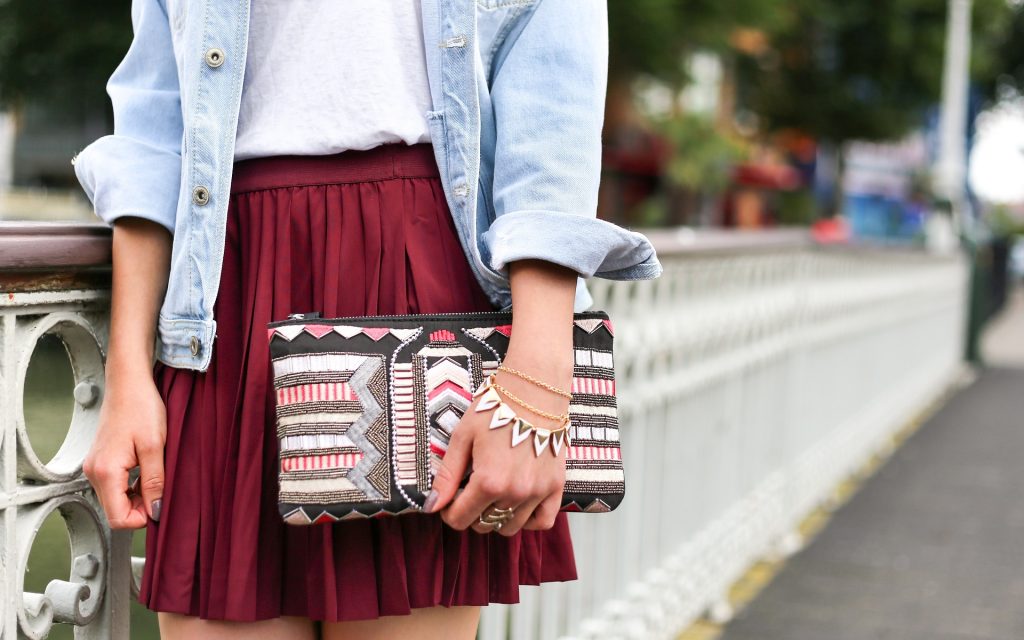Jewelry is often seen as a way to make a fashion statement. It can be used to accessorize an outfit, add a touch of personal style, or make a person feel more confident. And in recent years, the jewelry industry has grown to reach a global market value of $228 billion.
With this booming figure comes new trends – one of which is permanent jewelry. This type of jewelry is becoming increasingly popular, especially among millennials. So if you’re looking to buy jewelry or want to incorporate something new into your current collection, here’s everything you need to know about this style trend.
What’s Permanent Jewelry?
As its name suggests, permanent jewelry is an accessory designed to be worn for a long time, if not permanently. It is made from various materials, including metals, plastics and biocompatible items.
The main appeal of permanent jewelry is that unlike traditional jewelry, which can be taken off and put back on at will, it is a more permanent way to express oneself. For some people, this means having a tangible reminder of their style; for others, it is a way to show commitment to a particular interest or belief.
As permanent jewelry is a relatively new trend, there are few definitive rules about what can or cannot be classified as such. However, most experts agree that the most common type of permanent jewelry is bracelets and necklaces. They’re more like traditional jewelry in that they look like your average bracelets or necklaces, unlike the trendy jewelry pieces you’ll see on runways. But once you look closely, there are no links or clasps – instead, the jewelry is one continuous piece.
How is Permanent Jewelry Put On?
The process of putting on a piece of permanent jewelry is not invasive and does not require any piercings. It works by placing a custom-fit bracelet or necklace over the desired area and gently welding it into place. Thus, many call it a zapped bracelet or necklace.
The process is simple and can be done quickly. It is also relatively painless, as the welder uses a low-heat setting. The welder will trim the excess material and polish the jewelry to look seamless. But although it seems like a basic process, it is essential to note that it should only be done by a professional. And as of now, there are no available do-it-yourself kits.
What are the Advantages of Permanent Jewelry?

Permanent jewelry is not only trendy but also has several benefits. If you’re still on the fence about whether or not to try this style trend, here are some advantages that may sway your decision:
Permanent jewelry is more comfortable than traditional jewelry
Because it does not have any clasps or links, it lays flat against the skin and moves with you instead of sitting on top of your skin. This feature eliminates the risk of the jewelry getting caught on clothing or snagging hair, which can be both painful and irritating.
Permanent jewelry is also less likely to cause skin irritation
The materials used in permanent jewelry are often biocompatible, meaning they are less likely to cause skin irritation. In fact, those with metal allergies can often wear permanent jewelry made from alternative materials without any problems. So if you have sensitive skin, this style trend may be worth trying.
Permanent jewelry is a great way to express yourself
If you want to show off your style or make a statement, permanent jewelry is a great way to do so. Because it is more permanent than traditional jewelry, it allows you to express yourself in a unique and personal way.
Permanent jewelry stays in place
This advantage is especially beneficial for those who have difficulty keeping their traditional jewelry in place. Whether you have an active lifestyle or have trouble keeping your jewelry from falling off, permanent jewelry is a great solution. It’s not called a forever bracelet or necklace for nothing!
Permanent jewelry is less likely to get lost
Another advantage of permanent jewelry is that it is less likely to get lost. Because it is welded into place, it is less likely to fall off and become misplaced. It is especially beneficial for those who have a habit of losing their jewelry.
What are the Disadvantages of Permanent Jewelry?

Of course, no style trend is perfect. And although permanent jewelry has several advantages, there are also some disadvantages to consider before getting zapped. These concerns are typically minor and can be quickly addressed, but they are still worth mentioning.
Permanent jewelry is only suitable for some
The most significant disadvantage of permanent jewelry is that it is only suitable for some. If you have skin issues, are pregnant, or have certain medical conditions, this style trend may not be ideal for you. It’s always best to consult with a professional before getting zapped. This way, you can ensure that the jewelry will not cause any problems or irritation.
Permanent jewelry is a commitment
Another disadvantage of permanent jewelry is that it is a commitment. Unlike traditional jewelry, which you can remove at any time, permanent jewelry is more or less permanent. So if you’re not sure you want to commit to this style trend, it may not be the right choice for you.
Metal detectors might detect permanent jewelry
If you’re a globetrotting fashionista, going through airport security or any other type of metal detector may be challenging when you’ve got permanent jewelry. That is because the metal in the jewelry can set off the sensor.
However, you can inform the security guard that you are wearing permanent jewelry, and they will likely let you through without any problems. But if you don’t want to deal with talking to an officer, you can opt for a non-metal material, such as plastic or resin.
Permanent jewelry can get in the way of medical tests
Medical tests, such as MRI, can be challenging to perform if you have permanent jewelry. That’s because the metal in the jewelry can interfere with the test results. Removing your permanent jewelry beforehand is best if you’re planning on having any medical test that requires you to take off your jewelry. Besides, there are service providers that will allow you to re-attach your jewelry after the test.
Can Permanent Jewelry Break?
Bonded bracelets are not unbreakable but much more durable than their non-bonded counterparts. However, the metals used in permanent jewelry are still susceptible to damage and breakage. So if you’re concerned about your jewelry breaking, it’s best to opt for a metal that is less likely to break, such as stainless steel.
You can also increase the durability of your permanent jewelry by getting it regularly serviced. This way, you can ensure that the metal is in good condition and won’t break easily.
How Permanent are Permanent Bracelets?
A permanent bracelet is a bracelet that’s welded or glued into place. That means this bracelet is not meant to be removed and can last several years. The average lifespan of a permanent bracelet is five to seven years. However, this can vary depending on the materials used and how well you take care of your bracelet.
If you take care of your bracelet and avoid exposing it to harsh chemicals or water, it can last even longer. So, it’s more accurate to say that a permanent bracelet is a bracelet that’s built to last.
How Do You Remove Permanent Jewelry?

Although permanent jewelry is not meant to be removed, there are still ways to remove it if you need to. The most common way to remove permanent jewelry is to have it cut off. It can be done by a professional, such as a piercer or jeweler. However, this applies only to particular materials, such as silver chains. Other materials, such as titanium, can’t be cut off and must be removed using alternative ways.
Another way to remove permanent jewelry is to dissolve the glue or welding holding it in place. This process can be done using a solvent, such as acetone. However, this method is not recommended to be done alone as it can damage your skin. It’s best to seek professional help when removing your permanent jewelry using this method.
Permanent jewelry can also be removed through surgery. It is the most extreme way to remove permanent jewelry and should only be done as a last resort. The surgery is usually quick and straightforward, but it can be costly.
How Much Do Permanent Bracelets Usually Cost?
The cost of a permanent bracelet can vary depending on the jewel brand, materials used, and the size of the bracelet. However, the average price of a simple link bracelet is around $90.
If you’re looking for a more affordable option, you can browse around local jewelry stores. Many online jewelers sell cheaper but still high-quality bracelets as well. Just make sure to do your research before buying to avoid getting scammed.
When shopping for a permanent bracelet, it’s best to consider the quality of the materials used and the design of the bracelet. This way, you can find a bracelet that not only looks good but is also durable and long-lasting.
Who Can Wear Permanent Jewelry?
Romantic partners, friends, and family members often make matching permanent bracelets to signify their bond. It’s a love bracelet that can be worn daily as a constant reminder of their relationship. Permanent bracelets are also popular among those who have undergone surgery as they signify strength and courage.
Almost anyone can wear permanent jewelry. However, those with medical conditions that might be aggravated by jewelry need to get clearance from their doctor first. Doing so will help avoid any complications from wearing the jewelry.
Aside from that, there are no restrictions on who can wear permanent jewelry. So whether you’re looking for a new fashion statement or a way to show your commitment, permanent jewelry is an excellent option.
What Do You Need to Do Permanent Jewelry?
Getting a piece of permanent jewelry is a simple process that you can accomplish at most jewelry stores. Here are some of the things you need to do:
Pick the Right Design
Before you get a permanent bracelet, it’s crucial to pick the right design. There are many factors to consider, such as the style of the bracelet, the materials used, and the overall look of the bracelet. It’s best to try on different designs before settling on one. Remember, you’ll be wearing the bracelet permanently, so it’s essential to pick a design that you’re comfortable with.
Prepare the Area
The area where you’ll be getting the permanent bracelet needs to be clean and free of any oil or dirt. The jeweler will take your measurements, so ensure the area is accessible. It would help if you also considered any allergies you might have before getting the bracelet.
Wait for the Bracelet
Your permanent bracelet is custom-made for you. The process usually takes around 2-3 weeks, but it might take longer, depending on the design of the bracelet. Once it’s ready, the jeweler will call you to have it installed.
Have it Installed
After the bracelet is ready, you must set an appointment for the installation. The process is usually quick and takes only minutes. However, you may need to stay longer to get some care instructions from the jeweler.
Post-Installation Care
After your permanent bracelet is installed, it’s essential to take care of it properly. Avoid getting it wet or exposing it to harsh chemicals. It’s also best to avoid pulling it or putting too much pressure on it. Regular cleaning and inspection will also help keep the bracelet in excellent condition.
If you follow these steps, you’re sure to have a beautiful and long-lasting permanent bracelet. Just remember to consult with a professional jeweler to ensure everything gets done correctly.
Permanent bracelets are a great way to show commitment to someone or something. They can be made from various materials and come in many different designs. If you’re considering getting a permanent bracelet, the above information will help you get started.





